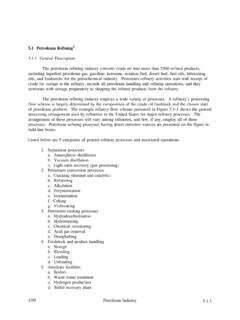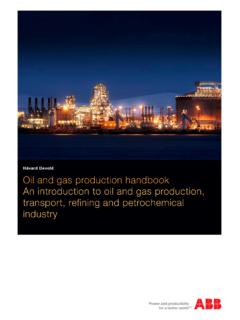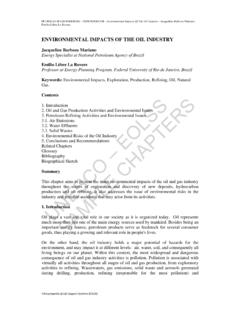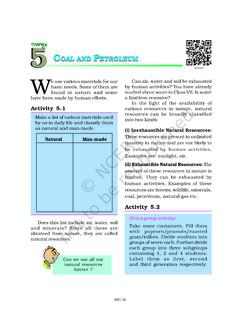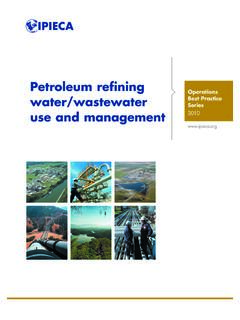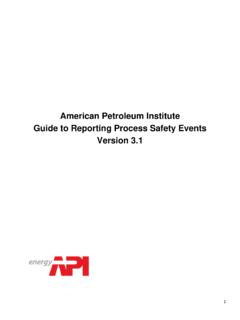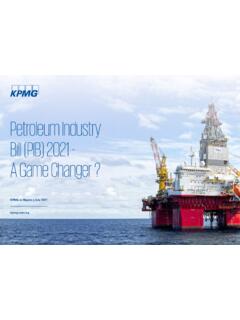Transcription of AP-42 Section 5.2: Transportation And Marketing Of ...
1 6/08 petroleum Transportation And Marketing Of petroleum GeneralThe Transportation and Marketing of petroleum liquids involve many distinct operations, each ofwhich represents a potential source of evaporation loss. Crude oil is transported from production operationsto a refinery by tankers, barges, rail tank cars, tank trucks, and pipelines. Refined petroleum products areconveyed to fuel Marketing terminals and petrochemical industries by these same modes. From the fuelmarketing terminals, the fuels are delivered by tank trucks to service stations, commercial accounts, and localbulk storage plants. The final destination for gasoline is usually a motor vehicle gasoline tank.
2 Similardistribution paths exist for fuel oils and other petroleum products. A general depiction of these activities isshown in Figure Emissions And ControlsEvaporative emissions from the Transportation and Marketing of petroleum liquids may beconsidered, by storage equipment and mode of Transportation used, in four tank cars, tank trucks, and marine vessels: loading, transit, and ballasting stations: bulk fuel drop losses and underground tank breathing vehicle tanks: refueling storage tanks: breathing, working, and standing storage losses. (See Chapter 7, "LiquidStorage Tanks".)Evaporative and exhaust emissions are also associated with motor vehicle operation, and these topicsare discussed in AP-42 Volume II: Mobile Sources.
3 Rail Tank Cars, Tank Trucks, And Marine Vessels -Emissions from these sources are from loading losses, ballasting losses, and transit losses. Loading Losses - Loading losses are the primary source of evaporative emissions from rail tank car, tank truck, andmarine vessel operations. Loading losses occur as organic vapors in "empty" cargo tanks are displaced to theatmosphere by the liquid being loaded into the tanks. These vapors are a composite of (1) vapors formed inthe empty tank by evaporation of residual product from previous loads, (2) vapors transferred to the tank invapor balance systems as product is being unloaded, and (3) vapors generated in the tank as the new productis being loaded.
4 The quantity of evaporative losses from loading operations is, therefore, a function of thefollowing parameters: - Physical and chemical characteristics of the previous cargo;- Method of unloading the previous cargo;- Operations to transport the empty carrier to a loading terminal;- Method of loading the new cargo; and- Physical and chemical characteristics of the new principal methods of cargo carrier loading are illustrated in Figure , Figure , and Figure In the splash loading method, the fill pipe dispensing the cargo is lowered only part way into the cargo tank. Significant turbulence and vapor/liquid contact occur during the splash EMISSION FACTORS6 Flow sheet of petroleum production, refining, and distribution systems.
5 (Points of organic emissions are indicated by vertical arrows.)6/08 petroleum Splash loading Submerged fill Bottom FACTORS6 (1)loading operation, resulting in high levels of vapor generation and loss. If the turbulence is great enough,liquid droplets will be entrained in the vented vapors. A second method of loading is submerged loading. Two types are the submerged fill pipe methodand the bottom loading method. In the submerged fill pipe method, the fill pipe extends almost to the bottomof the cargo tank. In the bottom loading method, a permanent fill pipe is attached to the cargo tank bottom. During most of submerged loading by both methods, the fill pipe opening is below the liquid surface level.
6 Liquid turbulence is controlled significantly during submerged loading, resulting in much lower vaporgeneration than encountered during splash loading. The recent loading history of a cargo carrier is just as important a factor in loading losses as themethod of loading. If the carrier has carried a nonvolatile liquid such as fuel oil, or has just been cleaned, itwill contain vapor-free air. If it has just carried gasoline and has not been vented, the air in the carrier tankwill contain volatile organic vapors, which will be expelled during the loading operation along with newlygenerated vapors. Cargo carriers are sometimes designated to transport only one product, and in such cases arepracticing "dedicated service".
7 Dedicated gasoline cargo tanks return to a loading terminal containing airfully or partially saturated with vapor from the previous load. Cargo tanks may also be "switch loaded" withvarious products, so that a nonvolatile product being loaded may expel the vapors remaining from a previousload of a volatile product such as gasoline. These circumstances vary with the type of cargo tank and withthe ownership of the carrier, the petroleum liquids being transported, geographic location, and season of theyear. One control measure for vapors displaced during liquid loading is called "vapor balance service", inwhich the cargo tank retrieves the vapors displaced during product unloading at bulk plants or servicestations and transports the vapors back to the loading terminal.
8 Figure shows a tank truck in vaporbalance service filling a service station underground tank and taking on displaced gasoline vapors for returnto the terminal. A cargo tank returning to a bulk terminal in vapor balance service normally is saturated withorganic vapors, and the presence of these vapors at the start of submerged loading of the tanker truck resultsin greater loading losses than encountered during nonvapor balance, or "normal", service. Vapor balanceservice is usually not practiced with marine vessels, although some vessels practice emission control bymeans of vapor transfer within their own cargo tanks during ballasting operations, discussed from loading petroleum liquid can be estimated (with a probable error of 30 percent)4using the following expression:where.
9 LL= loading loss, pounds per 1000 gallons (lb/103 gal) of liquid loaded S = a saturation factor (see Table )P = true vapor pressure of liquid loaded, pounds per square inch absolute (psia) (see Section , "Organic Liquid Storage Tanks") M = molecular weight of vapors, pounds per pound-mole (lb/lb-mole) (see Section , "OrganicLiquid Storage Tanks")T = temperature of bulk liquid loaded, R ( F + 460)6/08 petroleum Tank truck unloading into a service station underground storage tank and practicing "vapor balance" form of emission SATURATION (S) FACTORS FOR CALCULATING petroleum LIQUIDLOADING LOSSESC argo CarrierMode Of OperationS FactorTank trucks and rail tank carsSubmerged loading of a clean cargo loading: dedicated normal loading: dedicated vapor balance loading of a clean cargo loading: dedicated normal loading: dedicated vapor balance vesselsaSubmerged loading: loading: products other than gasoline and crude oil.
10 For marine loading of gasoline, use factors from Table For marine loading of crude oil, use Equations 2 and 3 and Table FACTORS6 Tank truck loading with vapor saturation factor, S, represents the expelled vapor's fractional approach to saturation, and it accounts for thevariations observed in emission rates from the different unloading and loading methods. Table listssuggested saturation factors. Emissions from controlled loading operations can be calculated by multiplying the uncontrolled emissionrate calculated in Equation 1 by an overall reduction efficiency term:The overall reduction efficiency should account for the capture efficiency of the collection system aswell as both the control efficiency and any downtime of the control device.










